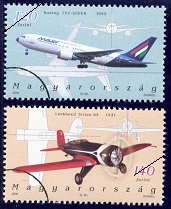HISTORY OF HUNGARIAN AVIATION III.
Date of issue: 16 March 2006

Lockheed made the Sirius entirely from wood using a special type of plywood. The fuselage was made by adhering several layers of wooden board on a concrete mould. The main 925 litre fuel tank was behind the bulkhead of the engine. The history of the first Hungarian trans-oceanic flight is bound to the Lockheed Sirius 8A. The Hungarian Ocean Aviation Committee, established in America, took possession of the Sirius at the Lockheed aircraft factory in the summer of 1930 and began test flights. After long trials the moment of the long-awaited takeoff arrived in the summer of 1931. Pilot György Endresz – whose name for Hungarians is synonymous with ocean aviation – and navigator Sándor Magyar flew their plane Justice for Hungary 6,000 km in the record time of 26 hours 20 minutes. The first transatlantic flight by Hungarians drew a great deal of international attention as it was the first such flight deep into continental Europe. (Source: Csanádi-Nagyatádi-Winkler: A magyar repülés története [The History of Hungarian Aviation])
The development of the Boeing 767 – a twin-engine airliner with
great cabin space and equipped with the latest technology – began on 14
July 1978. The basic model, the 767-200 took to the air for the first
time on 26 September 1981. For middle distances the heavier version of
the basic model was recommended, while the 767-200ER was the longrange
variation. MALÉV Hungarian Airlines first flew from Budapest to New York
with a Boeing 767-200ER in 1993.
The denominations of the special
series show graphics of the aeroplanes, and technical drawings of the
planes from above and the front in the background. The design of the
first day cover shows a composition indicating the routes of the
aircraft shown on the stamps, and the postmark depicts an allegoric
expression of flight.
Order code:
2006040050211 (stamp)
2006040060012 (FDC)
Date of issue: 16 March 2006
Face value: HUF 120, 140
Number of copies: 350.000 sets
Printing method: offset
Perforated size: 50 x 30 mm
Printed by Pénjegynyomda Zrt.
Designed by László Dudás

